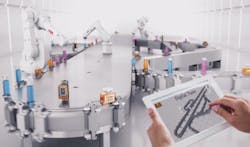The Adaptive Machine for Mass Customization
Some of the biggest challenges facing consumer packaged goods manufacturers include product proliferation, the need to provide more product options and variants to the market, life cycle reductions, quicker format changes, different labels, special runs, seasonal production, unpredictable demand driven by e-commerce, and mass customization.
In response to these new market realities, Derrick Stacey, product manager, North America, at B&R Industrial Automation, said the industry requires “a new generation of machine—an adaptive machine—that adapts to products and the way they need to be produced instead of producing products in a rigidly sequential process. This machine also need to be in line with critical digital business models such as build-to-order, e-commerce, direct-to-consumer, and mass customization operations, all while being cost effective at producing batch-size-of-one.”
He said this adaptive machine must allow for instant, on-the-fly changeovers and cost-effective personalization.
According to Stacey, B&R uses four of its technologies to create an adaptive machine for its customers. Those technologies are the company’s AcoposTrak, integrated machine vision, machine centric robotics, and built-in digital twin.
“AcoposTrak is based on long stator linear motor technology and is the backbone of the adaptive machine,” Stacey said. “AcoposTrak allows for individual and independent control of each product through sequential or parallel processes. Each product only stops at the stations required. AcoposTrak is highly adaptable with its flexible, fully configurable, and hot swappable shuttles that can also work with robot tending.”
With digital twin capability as part of the adaptive machine, the system “allows for full simulation and optimization before any metal is cut,” Stacey said. “Combined with AcoposTrak, we have the perfect orchestration between machine and robots for cutting edge synchronization and flexibility.”
He added that all of these capabilities are layered into “an integrated architecture through which we implement all functions—not just AcoposTrack or vision or robotics, but also standard motion control, logic, safety, and data collection—in one environment for development, operation, service, and future modifications.”
About the Author
David Greenfield, editor in chief
Editor in Chief

Leaders relevant to this article:
